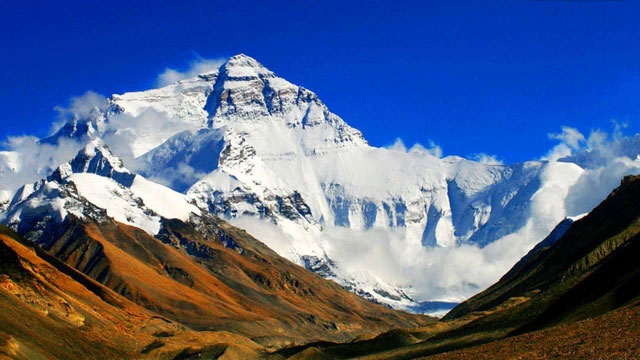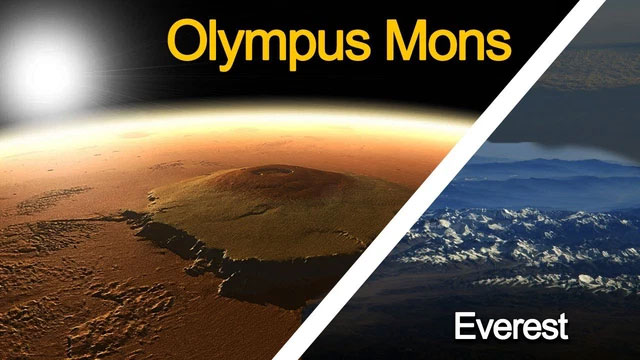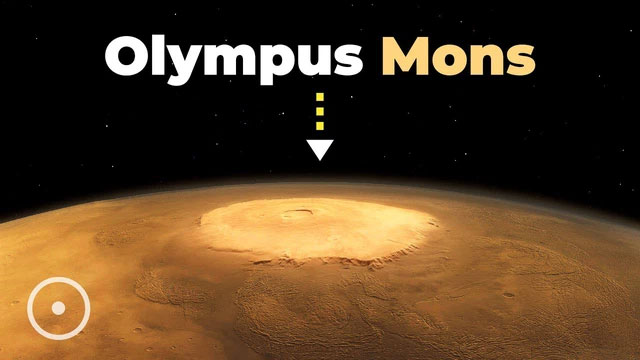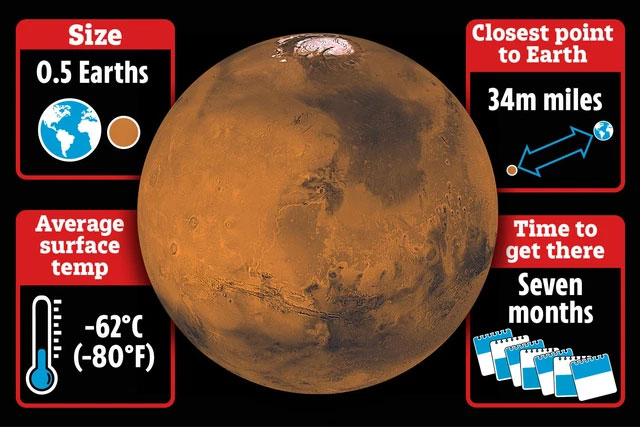The highest peak on Earth is Mount Everest, and the highest peak on Mars is Olympus Mons. However, when compared to other mountains on Mars, the mountains on Earth are merely “small fry.”
Mount Chomolungma, or Everest, is the main peak of the Himalayas, located on the border between China and Nepal. Mount Everest is not only the highest peak in China but also the highest in the world, standing at an elevation of 8,848.86 meters. The entire Everest mountain has the shape of a gigantic and majestic pyramid with steep terrain, covered in snow year-round.
With “Chomo” meaning goddess in Tibetan and “lungma” meaning mother, Mount Everest is not just a sacred mountain in China but is also revered as the world’s sacred mountain.

Mount Everest is the highest mountain on Earth.
Mount Everest is the highest mountain on Earth above sea level, currently measured at 8,848.86 meters. It has decreased in height by 2.4 cm following the earthquake in Nepal on April 25, 2015, and has shifted 3 cm to the southwest. The border between Nepal and China runs through the peak of Everest.
On our planet, there are over 40 peaks higher than 7,000 meters above sea level, and Mount Everest is dubbed the highest of the high peaks. Additionally, there are several other famous mountains similar to Everest, such as Lhotse, the fourth highest in the world at an elevation of 8,501 meters above sea level; Makalu, the fifth highest at 8,470 meters; and Cho Oyu, which stands at 8,153 meters above sea level. Further west is Shishapangma, the lowest of the 14 peaks over 8,000 meters, at 8,012 meters above sea level.
Therefore, the peaks surrounding Everest are always considered the best places for humans to challenge themselves with extreme mountain climbing. Since Everest is the highest peak, the air at the summit is very thin, cold, and the climate is extremely harsh, making it also the highest place for humans to test their climbing limits.
It wasn’t until May 29, 1953, that humans first successfully climbed to the summit of Everest, accomplished by New Zealand climber Edmund Hillary and Nepalese guide Tenzing Norgay. However, Everest is still nothing compared to the highest mountain on Mars.
Olympus Mons
Olympus Mons is a shield volcano on Mars. A shield volcano is a large volcano with a broad, gentle slope, resembling a shield. Shield volcanoes also exist in large numbers on Earth; for example, the Big Island of Hawaii is a typical shield volcano with an area of 10,414 square kilometers and a height of about 4,000 meters.

Olympus Mons on Mars (left) and Mount Everest on Earth (right).
The largest shield volcano on Earth is considered “Pu’u ‘Ō’ō”, a volcano hidden beneath the blue waters of the northwestern Hawaiian islands, measuring 275 km long and 90 km wide, but only 52 meters high.
However, Olympus Mons on Mars is much larger than the shield volcanoes on Earth. This mountain is located at 18.65 degrees north latitude and 226.2 degrees east longitude on Mars. It is about 600 km wide and covers an area of approximately 300,000 square kilometers. The elevation from the base of Mars (since Mars does not have a sea level, the base elevation is equivalent to Earth’s elevation) to the summit is 21,171 meters, and the height from the base to the summit reaches 21.9 km, which is over 27 km higher than the plains located 1,000 km to the northwest.

The grandeur and magnificence of Olympus Mons are considered unique in the Solar System.
If the geodetic datum of Mars were equivalent to Earth’s sea level, then the height of Olympus Mons would be nearly 2.4 times that of Earth’s Everest! The caldera of this shield volcano consists of six overlapping collapse pits, measuring 80 x 60 km.
To date, the grandeur and magnificence of Olympus Mons remain unique in the Solar System, and no other planet has been found to have a mountain as large as this. Due to its colossal size, we cannot see its full image from the surface of Mars.
The atmospheric pressure on Mars is very low, only about 0.75% of Earth’s atmospheric pressure, and at the summit of Olympus Mons, the pressure there is only 8% of Mars’ baseline; at the summit of Everest, the atmospheric pressure is 33%. Therefore, it can be seen that the environment of Olympus Mons would be much worse and harsher than that of Everest.
Why Are Mountains on Mars Taller and Larger than Those on Earth?
To answer this, we first need to understand some basic data about Earth and Mars:
The mass of Earth is approximately 5.972 x 10^24 kg, with a radius of about 6,371 km, and the gravitational acceleration on Earth’s surface is 9.82 m/s^2; the mass of Mars is about 6.417 x 10^23 kg, with a radius of approximately 3,390 km, and the gravitational acceleration on Mars’ surface is 3.73 m/s^2. From this, we can see that Earth’s mass is 9.3 times that of Mars, and its gravitational force is about 2.63 times stronger than that of Mars.

The main reason mountains on Mars are taller than those on Earth is due to gravitational force.
This means that Mars’ mass is only 1/9.3 of Earth’s mass, and its gravitational force is only 38% of Earth’s.
Based on this data, we can infer that the main reason mountains on Mars are taller than those on Earth is due to gravitational force. In the study of all celestial bodies, it has been found that the larger the mass of a celestial body, the closer it will be to the shape of a perfect sphere, and conversely, smaller asteroids tend to have irregular shapes.
The gravitational pull of Earth is stronger than that of Mars, making it difficult for mountains to grow very tall. Scientists believe that under Earth’s actual conditions, mountain peaks could potentially reach heights exceeding 15,000 meters, but at such heights, they would collapse under the pressure of gravity. Additionally, Earth’s atmosphere is thick, and the flow within the atmosphere has formed complex climates, winds, frost, rain, and snow have eroded and weathered for hundreds of millions of years, which also prevents mountains on Earth from growing as tall as those on Mars.
Research suggests that Mount Everest was formed due to the collision and uplift of tectonic plates. It was over 10,000 meters high 13 million years ago, but ultimately it collapsed under the effects of gravity and weather, gradually becoming what it is today.


















































